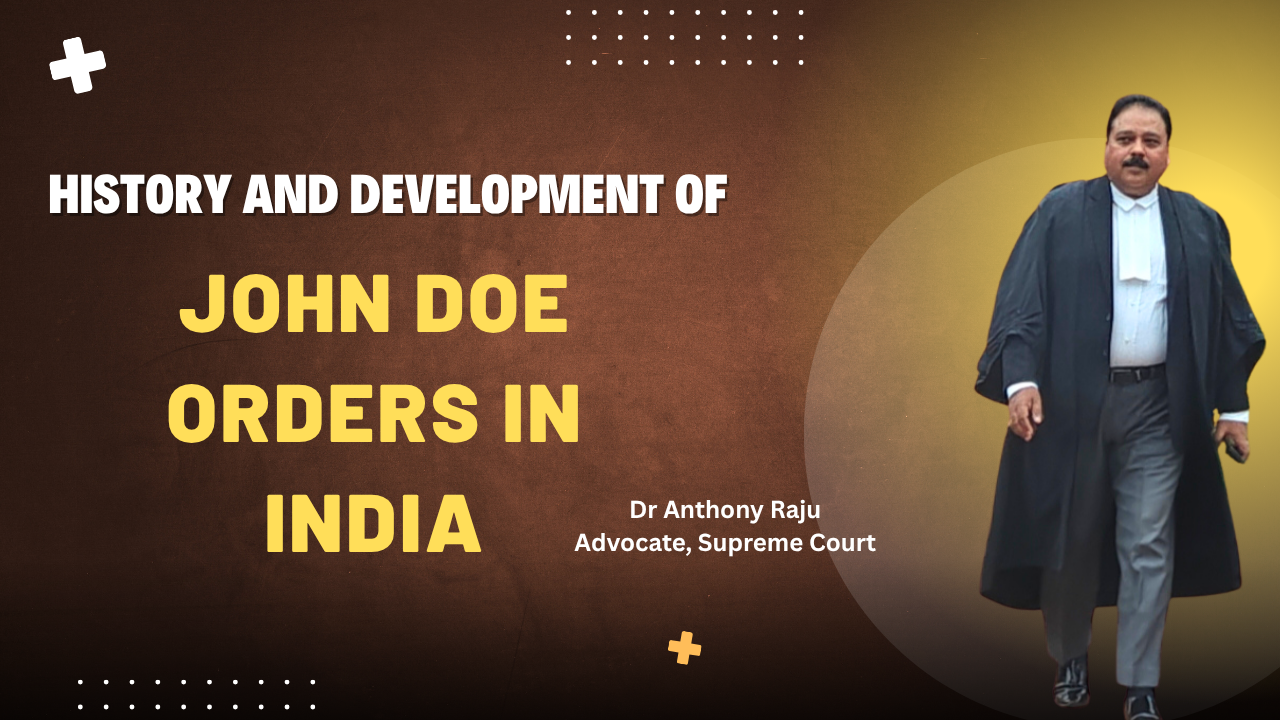History and Development of John Doe Orders in India
By Dr. Anthony Raju, Advocate, Supreme Court of India & Chairman, All India Council of Human Rights, Liberties and Social Justice
Introduction
In a rapidly globalizing and digitalized world, intellectual property and proprietary rights face an unprecedented onslaught from anonymous infringers. The Indian judiciary, known for its dynamic interpretation of procedural law, has progressively evolved legal tools to address such invisible violations. Among these innovations stands the John Doe Order—a potent judicial mechanism designed to safeguard legal rights even against unknown wrongdoers.
The jurisprudential journey of John Doe Orders, also referred to as Ashok Kumar Orders in India, represents a fine blend of equity, innovation, and judicial foresight. It signifies the Indian courts’ willingness to adapt traditional procedural frameworks to meet the challenges of modern infringement—whether in intellectual property, broadcasting rights, digital piracy, or cyberspace violations.
The Concept and Jurisprudential Foundation
The term “John Doe” originates from English common law, where it served as a placeholder name for anonymous or unidentified defendants. It was later adopted in the United States and other common law jurisdictions. The central premise of a John Doe order is that justice cannot be frustrated merely because the identity of the wrongdoer is presently unknown.
In the Indian context, this principle is grounded in Order XXXIX, Rules 1 and 2 of the Code of Civil Procedure, 1908, which empowers courts to grant injunctions to prevent the commission of an apprehended wrong. Such orders are in the nature of quia timet actions—that is, preventive remedies sought where an unlawful act is anticipated, and immediate judicial intervention is necessary to prevent irreparable harm.
Historical Evolution in India
The Indian judiciary’s recognition of John Doe Orders as an equitable necessity can be traced to Taj Television Ltd. v. Rajan Mandal & Ors. (2002), decided by the Hon’ble Delhi High Court. In that landmark judgment, the Court granted the first-ever John Doe injunction to restrain unauthorised cable operators from illegally broadcasting the FIFA World Cup, to which the plaintiff held exclusive rights.
This precedent opened the doors for intellectual property owners, broadcasters, and content creators to protect their rights even before infringement materialized fully. The Court, while granting relief, observed that in an era of rampant technological reproduction, the inability to identify offenders cannot be a ground to deny legal protection.
Subsequent cases consolidated this jurisprudence:
- ESPN Software India Pvt. Ltd. v. Tudu Enterprises (2011) expanded its application to digital platforms and rogue cable networks.
- UTV Software Communication Ltd. v. 1337x.to & Ors. (2019) took the doctrine further by introducing the concept of dynamic injunctions, allowing plaintiffs to block mirror websites and emerging infringing links without the need to return to court repeatedly.
These judicial innovations mark the Indian judiciary’s recognition that traditional remedies must evolve in sync with technological advancement.
The Legal Architecture and Judicial Philosophy
At its core, the John Doe or Ashok Kumar Order is an instrument of preventive justice, aimed at preserving the sanctity of legal rights before they are irreparably diluted. It is premised upon:
- Imminent Threat of Infringement: The plaintiff must demonstrate a real and immediate threat of harm.
- Prima Facie Right: There must exist a clear, protectable legal or proprietary right.
- Balance of Convenience: The balance must favour the grant of injunction to prevent injustice.
- Irreparable Injury: The damage anticipated must be of such nature that monetary compensation cannot suffice.
The Courts, while issuing such orders, have stressed the necessity of judicial restraint, ensuring that orders are specific, time-bound, and not excessive in scope. This ensures that such extraordinary remedies do not transgress into the territory of arbitrary or overbroad enforcement.
Dr. Anthony Raju’s Perspective
“The evolution of John Doe Orders in India represents a significant stride in harmonizing procedural law with the demands of the digital age. The Courts have, with commendable foresight, ensured that justice is not defeated merely by anonymity or technological complexity,” says Dr. Anthony Raju, Advocate, Supreme Court of India.
“However,” he cautions, “while these orders serve as essential tools for the protection of intellectual property and broadcast rights, their exercise must remain judicious, proportionate, and transparent. The sanctity of due process and the rights of unknown or future defendants must be preserved even as the courts protect identifiable claimants.”
Dr. Raju further emphasizes that judicial innovation must always be tempered with constitutional sensitivity. The issuance of John Doe orders against “the world at large” creates a unique legal situation—where individuals, yet unidentified, are bound by a decree. Therefore, judicial discretion must be exercised with utmost circumspection, fairness, and clarity of scope.
John Doe Orders in the Digital and Cyber Era
The proliferation of online content and the anonymity provided by the internet have magnified the relevance of John Doe Orders. Today, they are not limited to television broadcasts or physical counterfeiting but extend to:
- Online piracy and illegal streaming of films, OTT content, and sports events
- Counterfeit e-commerce operations and trademark violations
- Unlawful dissemination of NFTs and digital art
- Cyber defamation and data theft cases involving anonymous perpetrators
Indian courts have progressively incorporated technological enforcement mechanisms, including dynamic injunctions, blockchain evidence, and coordination with Internet Service Providers (ISPs), to give practical effect to such orders.
Challenges and Future Directions
While the jurisprudence of John Doe Orders is laudable, certain challenges persist:
- Over-Blocking: Unintended blocking of legitimate websites or entities not involved in infringement.
- Lack of Uniform Enforcement Protocols: Varying responses by ISPs and regulatory authorities hinder consistency.
- Limited Awareness among Law Enforcement Agencies: Implementation often depends on proactive coordination between rights holders and authorities.
- Need for Legislative Codification: There remains scope for Parliament to formally recognize and regulate the contours of John Doe Orders under statutory law.
Dr. Raju advocates for a balanced legislative framework:
“Codifying the principles governing John Doe Orders will enhance consistency, safeguard due process, and provide clear procedural guidelines for enforcement. The goal should be to strengthen rights without stifling access to information or legitimate digital use.”
Conclusion
The evolution of John Doe Orders in India epitomizes the judiciary’s responsiveness to emerging realities of the information age. It underscores that the Indian legal system is not static but capable of progressive adaptation. The courts have demonstrated that justice must not be held hostage to identification—that the law, like society, must evolve to meet the demands of technology and time.
Under the visionary perspectives of jurists like Dr. Anthony Raju, these orders are not merely instruments of litigation but embodiments of a broader legal philosophy: that every right must have an effective remedy, and every remedy must be adaptable to changing contexts.
Keywords & Tags
#JohnDoeOrder #AshokKumarOrder #IndianJurisprudence #IPRIndia #DigitalJustice #SupremeCourtAdvocate #DrAnthonyRaju #DelhiHighCourt #DynamicInjunction #PreventiveJustice #HumanRightsAndLaw #LegalInnovation

